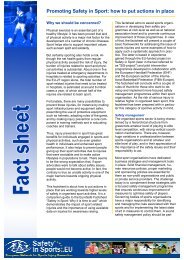Burden of Sport Injuries in the European Union - Safety in Sports
Burden of Sport Injuries in the European Union - Safety in Sports
Burden of Sport Injuries in the European Union - Safety in Sports
You also want an ePaper? Increase the reach of your titles
YUMPU automatically turns print PDFs into web optimized ePapers that Google loves.
7 Disabilities<br />
7.1 Methodology<br />
45<br />
7 | February 2012<br />
Probably <strong>the</strong> most expensive and most grievous consequences <strong>of</strong> <strong>in</strong>juries are longterm<br />
or even life-long disabilities. It is clear that sport <strong>in</strong>juries lead <strong>in</strong> many cases to<br />
long-term consequences, e.g. due to ligament ruptures. So far, <strong>the</strong>re are no comparable<br />
measures available which allow for <strong>the</strong> comparison <strong>of</strong> groups <strong>of</strong> <strong>in</strong>juries regard<strong>in</strong>g<br />
<strong>the</strong>ir risk <strong>of</strong> disabilities. The various national and regional data, which are based<br />
on <strong>in</strong>surance or welfare statistics (e.g. on disability pensions, attendance allowances,<br />
restrictions <strong>of</strong> employability), are hardly comparable due to <strong>the</strong> vary<strong>in</strong>g systems.<br />
Usual <strong>in</strong>dicators for severity, as <strong>the</strong> commonly used Abbreviated Injury Scale (AIS)<br />
(Association for <strong>the</strong> Advancement <strong>of</strong> Automotive Medic<strong>in</strong>e 2005) are less vivid, as<br />
<strong>the</strong>y do not provide a dist<strong>in</strong>ction between severe <strong>in</strong>juries which can be cured completely<br />
and <strong>in</strong>juries which affects <strong>the</strong> life permanently. Such severity <strong>in</strong>dicators do<br />
not allow for estimat<strong>in</strong>g <strong>the</strong> health burden <strong>of</strong> groups <strong>of</strong> <strong>in</strong>juries <strong>in</strong> terms <strong>of</strong> disability-<br />
Adjusted Life Years (DALYs), which is a conv<strong>in</strong>c<strong>in</strong>g measure for <strong>the</strong> overall health<br />
burden due to a specific disease. DALYs comb<strong>in</strong>e mortality and morbidity <strong>in</strong>dicators<br />
<strong>in</strong>to one easily understandable measure and are <strong>the</strong> simple sum <strong>of</strong> Year <strong>of</strong> Life Lost<br />
(YLLs) due to premature death, and Years Lived with Disabilities YLDs (Murray<br />
1996, Pol<strong>in</strong>der et al. 2007).<br />
A relatively new method for calculat<strong>in</strong>g <strong>the</strong> risk for disability <strong>of</strong> <strong>in</strong>juries has been<br />
proposed by Van Beeck et al. (2007), <strong>the</strong> so-called Injury Disability Weight (IDW) (see<br />
also Haagsma et al. 2008, 2010, Belt & al. 2010). Van Beek & at (2007) have established<br />
probability weights for long-term disabilities assigned to 39 groups <strong>of</strong> ICD <strong>in</strong>jury<br />
diagnoses, and this methodology has been fur<strong>the</strong>r developed for <strong>the</strong> EU IDB under<br />
<strong>the</strong> INTEGRIS-project (“Improved methodology for data collection on accidents and<br />
disabilities”). The INTEGRIS disability component is calculated by multiply<strong>in</strong>g <strong>the</strong><br />
number <strong>of</strong> <strong>in</strong>jury cases with a certa<strong>in</strong> health outcome and a predef<strong>in</strong>ed empirically<br />
established disability weight (table/figure 14). For example, an <strong>in</strong>jury patient with<br />
bra<strong>in</strong>-skull <strong>in</strong>jury treated at <strong>the</strong> ED has a disability weight <strong>of</strong> 0.09, whereas for hospitalized<br />
patients <strong>the</strong> disability weight is 0.241. 13% <strong>of</strong> <strong>the</strong> ED and 23% <strong>of</strong> <strong>the</strong> HDR cases<br />
with bra<strong>in</strong>-skull <strong>in</strong>jury suffer from lifelong consequences; <strong>the</strong> disability weight for<br />
<strong>the</strong>se lifelong consequences is 0.323. The YLD <strong>of</strong> lifelong <strong>in</strong>jury is <strong>the</strong>n calculated by<br />
multiply<strong>in</strong>g <strong>the</strong> number <strong>of</strong> cases with lifelong <strong>in</strong>jury, <strong>the</strong> disability weight and <strong>the</strong><br />
average duration.



